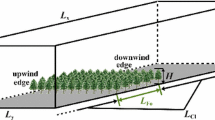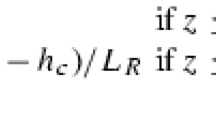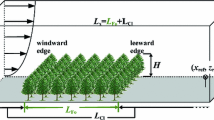Abstract
Forest edges have significant impacts on flow dynamics and mass exchange across the forest–atmosphere interface. A better understanding of edge flows and scalar transport has implications for locating and interpreting eddy-covariance flux measurements over finite-size forests with edges. Here the large-eddy simulation module within the Weather Research and Forecasting model is deployed to study the influence of forest edges on flow dynamics and scalar transport for a range of vertical distributions of foliage and scalar sources/sinks. For plant canopies with a relatively dense trunk space, a strong in-canopy flow convergence develops near the leading edge, which dominates the flow dynamics and leads to distinct scalar concentration and flux patterns not only across edges but also across the forest–atmosphere interface for sources near the ground and lower part of the canopy. For plant canopies with a deep, sparse trunk space, a strong and long sub-canopy jet develops, leading to simpler features in flow dynamics and scalar transfer. A real case with scalar sources/sink distributions as simulated by a newly developed multiple-layer canopy module produces even more complex scalar concentration and flux patterns. The budget equations for scalars are also analyzed to quantify the contributions of different terms to scalar fluxes. Our results demonstrate that both the scalar source distributions and canopy structures should be considered when eddy-covariance flux measurements are made over finite-size forests with edges.












Similar content being viewed by others
References
Belcher SE, Jerram N, Hunt JCR (2003) Adjustment of a turbulent boundary layer to a canopy of roughness elements. J Fluid Mech 488:369–398
Belcher SE, Harman IN, Finnigan JJ (2012) The wind in the willows: flows in forest canopies in complex terrain. Annu Rev Fluid Mech 44:479–504
Bonan GB (2008) Forests and climate change: forcings, feedbacks, and the climate benefits of forests. Science 320:1444–1449
Bou-Zeid E, Meneveau C, Parlange M (2005) A scale-dependent Lagrangian dynamic model for large eddy simulation of complex turbulent flows. Phys Fluids 17:025105
Cassiani M, Katul GG, Albertson JD (2008) The effects of canopy leaf area index on airflow across forest edges: large-eddy simulation and analytical results. Boundary-Layer Meteorol 126:433–460
Dupont S, Brunet Y (2008) Edge flow and canopy structure: a large-eddy simulation study. Boundary-Layer Meteorol 126:51–71
Dupont S, Brunet Y (2009) Coherent structures in canopy edge flow: a large-eddy simulation study. J Fluid Mech 630:93–128
Dupont S, Bonnefond JM, Irvine MR, Lamaud E, Brunet Y (2011) Long-distance edge effects in a pine forest with a deep and sparse trunk space: in situ and numerical experiments. Agric For Meteorol 151:328–344
Dupont S, Irvine MR, Bonnefond JM, Lamaud E, Brunet Y (2012) Turbulent structures in a pine forest with a deep and sparse trunk space: stand and edge regions. Boundary-Layer Meteorol 143:309–336
Foken T, Serafimovich A, Eder F, Hübner J, Gao Z, Liu H (2017) Interaction forest–clearing. In: Foken T (ed) Energy and matter fluxes of a spruce forest ecosystem, vol 229. Springer, Berlin, pp 309–329
Kanani F, Traeumner K, Ruck B, Raasch S (2014) What determines the differences found in forest edge flow between physical models and atmospheric measurements? An LES study. Meteorol Z 23:33–49
Kanani-Sühring F, Raasch S (2015) Spatial variability of scalar concentrations and fluxes downstream of a clearing-to-forest transition: a large-eddy simulation study. Boundary-Layer Meteorol 155:1–27
Kanani-Sühring F, Raasch S (2017) Enhanced scalar concentrations and fluxes in the lee of forest patches: a large-eddy simulation study. Boundary-Layer Meteorol 164:1–17
Kanani-Sühring F, Falge E, Voß L, Raasch S (2017) Complexity of flow structures and turbulent transport in heterogeneously forested landscapes: large-eddy simulation study of the Waldstein site. In: Foken T (ed) Energy and matter fluxes of a spruce forest ecosystem. Ecological Studies (Analysis and Synthesis), vol 229
Katul GG, Finnigan JJ, Poggi D, Leuning R, Belcher SE (2006) The influence of hilly terrain on canopy-atmosphere carbon dioxide exchange. Boundary-Layer Meteorol 118:189–216
Klaassen W, van Breugel PB, Moors EJ, Nieveen JP (2002) Increased heat fluxes near a forest edge. Theor Appl Climatol 72:231–243
Kröniger K, Banerjee T, De Roo F, Mauder M (2017) Flow adjustment inside homogeneous canopies after a leading edge—an analytical approach backed by LES. Agric For Meteorol 255:17–30
Ma Y, Liu H (2017) Large-eddy simulations of atmospheric flows over complex terrain using the immersed-boundary method in the weather research and forecasting model. Boundary-Layer Meteorol 75:1–25
Ma Y, Liu H (2019) An advanced multiple-layer canopy model in the Weather Research and Forecasting (WRF) model with large-eddy simulations to simulate canopy flows and scalar transport under different stability conditions. J Adv Model Earth Syst. https://doi.org/10.1029/2018MS001347
Markfort CD, Porté-Agel F, Stefan HG (2014) Canopy-wake dynamics and wind sheltering effects on Earth surface fluxes. Environ Fluid Mech 14:663–697
Oldroyd HJ, Katul G, Pardyjak ER, Parlange MB (2014) Momentum balance of katabatic flow on steep slopes covered with short vegetation. Geophys Res Lett 41:4761–4768
Oleson K, Lawrence M, Bonan B, Drewniak B, Huang M, Koven D, Levis S, Li F, Riley W, Subin Z, Swenson S, Thornton P (2013) Technical description of version 4.5 of the Community Land Model (CLM)
Patton EG, Horst TW, Sullivan PP, Lenschow DH, Oncley SP, Brown WO, Burns SP, Guenther AB, Held A, Karl T, Mayor SD (2011) The canopy horizontal array turbulence study. Bull Am Meteorol Soc 92(5):593–611
Porté-Agel F, Meneveau C, Parlange MB (2000) A scale-dependent dynamic model for large-eddy simulation: application to a neutral atmospheric boundary layer. J Fluid Mech 415:261–284
Ross AN, Baker TP (2013) Flow over partially forested ridges. Boundary-Layer Meteorol 146:375–392
Ross AN, Harman IN (2015) The impact of source distribution on scalar transport over forested hills. Boundary-Layer Meteorol 156:211–230
Schlegel F, Stiller J, Bienert A, Maas H-G, Queck R, Bernhofer C (2012) Large-eddy simulation of inhomogeneous canopy flows using high resolution terrestrial laser scanning data. Boundary-Layer Meteorol 142:223–243
Shaw RH, Schumann U (1992) Large-eddy simulation of turbulent flow above and within a forest. Boundary-Layer Meteorol 61:47–64
Skamarock W, Klemp J, Dudhia J, Gill D, Barker D, Duda M, Huang X, Wang W, Powers J (2008) A description of the advanced research WRF version 3. NCAR, Boulder
Sogachev A, Leclerc MY, Zhang G, Rannik Ü, Vesala T (2008) CO2 fluxes near a forest edge: a numerical study. Ecol Appl 18:1454–1469
Stull RB (2012) An introduction to boundary layer meteorology, vol 13. Springer, Berlin
Xue M, Lin SJ (2001) Numerical equivalence of advection in flux and advective forms and quadratically conservative high-order advection schemes. Mon Weather Rev 193:561–565
Yang B, Raupach MR, Shaw RH, Morse AP (2006) Large-eddy simulation of turbulent flow across a forest edge. Part I: flow statistics. Boundary-Layer Meteorol 120:377–412
Yi C (2008) Momentum transfer within canopies. J Appl Meteorol Clim 47:262–275
Yi C, Pendall E, Ciais P (2015) Focus on extreme events and the carbon cycle. Environ Res Lett 10:70201–70208
Acknowledgements
We are grateful to two anonymous reviewers for their constructive comments which greatly improved the quality of this manuscript. We acknowledge support by National Science Foundation AGS under Grants #1419614. We would like to acknowledge high-performance computing support from Cheyenne (https://doi.org/10.5065/d6rx99hx) provided by NCAR’s Computational and Information Systems Laboratory, sponsored by the National Science Foundation.
Author information
Authors and Affiliations
Corresponding author
Additional information
Publisher's Note
Springer Nature remains neutral with regard to jurisdictional claims in published maps and institutional affiliations.
Appendix: Flux Budget Equations Over a Forest Edge
Appendix: Flux Budget Equations Over a Forest Edge
Assuming neutral stratification, steady-state flow, homogeneity in the spanwise direction, and ignoring the subgrid-scale contribution (Stull 2012), the budget equation for the resolved-scale momentum flux \( u^{\prime}w^{\prime} \) can be written as
The terms on the right-hand side of Eq. 3 represent, respectively, advection by the mean flow (3a), shear production by the velocity gradient (3b), flux transported by turbulent motions (3c), and pressure re-distribution effect (3d).
Similarly, for any scalar c (e.g., CO2), the resolved-scale scalar flux \( w^{\prime}c^{\prime} \) can be written as
The terms on the right-hand side of Eq. 4 represent, respectively, advection by the mean flow (4a), shear production by the velocity gradient (4b), shear production by the scalar gradient (4c), flux transported by turbulent motions (4d), the pressure re-distribution effect (4e).
Figure 12 shows the three terms in the CO2 and water vapour flux budget for case 1 (uniformly distributed LAI). All the terms are normalized in this figure.
Rights and permissions
About this article
Cite this article
Ma, Y., Liu, H., Liu, Z. et al. Influence of Forest-Edge Flows on Scalar Transport with Different Vertical Distributions of Foliage and Scalar Sources. Boundary-Layer Meteorol 174, 99–117 (2020). https://doi.org/10.1007/s10546-019-00475-y
Received:
Accepted:
Published:
Issue Date:
DOI: https://doi.org/10.1007/s10546-019-00475-y




